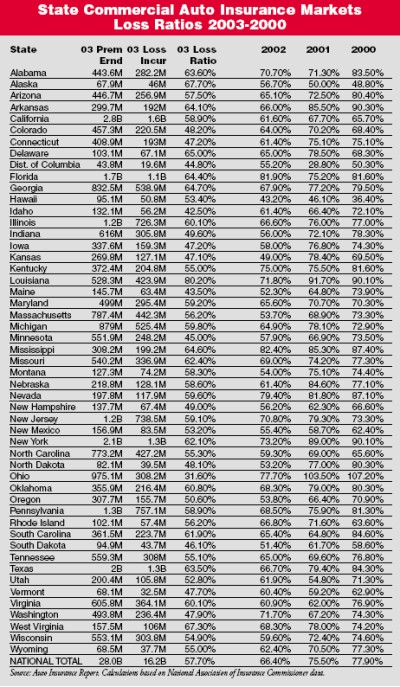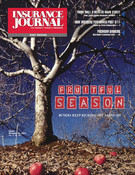The commercial auto market went through some tough times. After years of deteriorating loss ratios, things have definitely turned around.
What does this mean for the marketplace? In some cases, prices have started to reverse direction after a series of increases since 1999.
Those price hikes did pay off. According to the Auto Insurance Report, commercial auto loss ratios improved in 45 of 51 state markets in 2003 from the previous year. The nationwide pure loss ratio tumbled from 66.4 percent in 2002 to 57.7 for 2003. That continued a steady improvement from 2000, when the figure soared to 77.9 percent. Most experts anticipate the positive trend to continue.

Other factors besides the price increases have contributed to making commercial auto a more profitable line, according to Craig Cornell, the president of San Diego-based InsuranceLighthouse.com.
“Vehicles are safer now with side-impact airbags. If you’re in an accident and hit someone, they’re less likely to get seriously injured. So that has a positive impact (on loss ratio). Ten years ago, drug testing employees was rare. Now any sizable company requires it. I think that has significantly reduced the on-the-road exposure. Overall, safety training and safety management are so much better than 10 years ago.”
Cornell also believes, at least in California, that an indirect factor has contributed to the better loss ratios.
“Many insureds have taken aggressive steps to manage their workers’ compensation exposure, which has a spillover effect on auto liability risk. If you’re trying to keep drivers from getting in accidents to avoid work comp claims, it has a similar impact on the commercial auto exposure.”
A softening market
While you would expect carriers to begin cutting commercial auto rates, most have taken a cautious approach.
“I’m seeing more decreases on the trucking side. Overall, it’s probably about a level playing field as far as our markets go,” said Lori Beaumont, the vice president of Crump Insurance of Memphis. “I am seeing lower pricing from some of our competitors.”
“The market clearly has softened in trucking. It’s not dramatic, but my estimate would be about 10 percent,” Cornell said. “From my perspective, there is an opportunity to reduce pricing for good, well-managed large accounts.”
Cornell believes that companies have taken vital steps to making themselves better risks, which has helped soften pricing. “The clients that I have been working with are much better managed today from a safety, loss control and claims management standpoint than five years ago. I think underwriters recognize that and are pricing accordingly.”
Charles M. Timmons Jr., the president and CEO of Canal Insurance Company, has observed some different trends in recent months. Although he has seen some price increases, he expects the status quo to continue.
“The market has firmed over the last four years. I suspect it will stay where it is for the next year,” Timmons said. “Part of the reasoning behind that is the investment return that you can get nowadays, and part of it is because the reinsurers remain concerned over the commercial auto business.”
The current pricing trends vary by the type of commercial auto risk.
“The majority of our business is long-haul,” said Timmons from Canal Insurance’s Greenville, S.C., office. “We do write local and intermediate in a variety of classes, but long-haul is the biggest portion of our business. The long-haul business has been less competitive in the last six months. We also have seen price-cutting, but less of it in long-haul than the local and intermediate classes.”
Beaumont also said her office focuses on the larger risks as well. “The bulk of what we write is trucking risks, whether it’s long-haul trucking, dump trucks or loggers. We have a big book of those risks versus contractors, pickups or public auto.”
She’s noticed one change recently in the long-haul market. “I’ve been seeing more requests for excess liability for professional truckers–more than I have in the last couple years. The truckers are dealing with different contracts and shippers that may require an extra million dollars of liability protection.”
Beaumont mentioned another trend that could hurt E&S writers. “On the business auto side of things, I’m starting to see more accounts go back to the standard market. When the market turned hard a few years back, standard markets weren’t writing any monoline auto. So on the surplus lines side, we saw more of that business. Now I’m seeing some of my renewals go back to the standard market for business auto–more often than a year ago.”
Cornell, who acts as an independent consultant rather than a broker, helps clients with the bid process. He thus gets a good feel for the marketplace. His research contradicts the belief that relatively few companies write trucking firms.
“When I started my consulting business three years ago, I was really surprised at how often we found that there are many different options in the marketplace. Most insureds have the perspective that there are only three or four insurance companies that would write their auto liability risk. It’s just not true.
“Trucking companies generally have an impression that it’s a really thin marketplace out there, and it’s not true,” Cornell added. “There are plenty of options.”
A looming threat
Despite the positive trend in loss ratio, insurers know they face a major challenge in today’s increasingly litigious environment. Timmons expressed his concern about inflated jury awards and their impact on the immediate future for commercial auto.
“Severity is a major concern for me. Jury awards are getting higher–in some cases, without regard to fault. We’ve had a number of instances where we were–in our estimation, and in most reasonable people’s estimation–not at fault, or very little at fault, and wound up paying large awards. It’s like a lottery mentality among some juries. It’s going to make pricing go up if that continues.”
Companies know they must continue their careful underwriting practices to maintain the current loss ratio trend in commercial auto.
What are the keys? “There are so many factors,” Timmons said. “The most important ones are driver experience and history, as well as the type of equipment and the territory.”
“It all goes to the attitude of the individual drivers and how management influences that attitude,” Cornell said. “When management actively trains drivers and reinforces safe behavior and punishes unsafe behavior, you tend to get safer firms. The more involved management is in safety, the better the risk.”
Cornell then listed some red flags that can identify poor commercial auto risks: “When management lets things go, pays lip service to safety, and maybe has only one 15-minute quarterly safety meeting.”
As long as agents and brokers can steer clear of these risks, they can find opportunity in the commercial auto market.
Topics Auto Profit Loss Trucking
Was this article valuable?
Here are more articles you may enjoy.


 Let Good Adjusters, Not Expensive Lawyers, Make the Difference on Claims, CEO Says
Let Good Adjusters, Not Expensive Lawyers, Make the Difference on Claims, CEO Says  ‘Great Resignation’ Enters Third Year as Workers Embrace AI, Upskilling, PwC Says
‘Great Resignation’ Enters Third Year as Workers Embrace AI, Upskilling, PwC Says  Coverage Needed: Hundreds of Thousands in SE Now in Flood Zones With New Maps
Coverage Needed: Hundreds of Thousands in SE Now in Flood Zones With New Maps  German Insurtech Wefox to Replace CEO After Board Rejects Mubadala Sales Plan
German Insurtech Wefox to Replace CEO After Board Rejects Mubadala Sales Plan 


